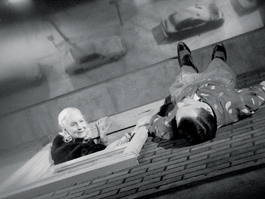home | metro santa cruz index | movies | current reviews | film review

Savage City: Ann Savage enjoys the view in 'My Winnipeg.'
Winnipeg Confidential!
Guy Maddin bathes in weird Canadian nostalgia in 'My Winnipeg'
By Richard von Busack
Boredom is as much a stimulus for art as excitement. My Winnipeg, Guy Maddin's portrait of his remote hometown "in the heart of the heart of North America," reveals this director's unique passion for the bygone.
Maddin (Brand Upon the Brain!, The Saddest Music in the World) presents to us a city surging with dark magic. As a civic booster's 45 rpm record from the 1950s burbles over the titles, we see the town that nestled Maddin: bus shelters, dirty man-high piles of snow, steaming buildings locked in endless frozen nights.
Homely it might be, but this city is built on a fertile crotch of rivers. Maddin merges a map of this watery intersection into the naked lap of a woman: a genuine lap dissolve. These rivers conceal deeper and more troubling pools. Maddin puts it plain: "Everything that happens in this city is a euphemism!"
He narrates the tale while an actor playing him tries to keep his eyelids open on the train out of town. Train? Hardly. It's a Streetcar Named Nostalgia and there's no getting off, all the way to the end of the line, and it's a one-way trip and the last stop is the cemetery. The inescapable gravity of Winnipeg draws "Maddin" into slumbering, living death. "What if I filmed my way out of here?" he asks, and then he turns his camera on this provincial capital of somnambulists.
As part of his last-ditch attempt to escape the town, Maddin purportedly restages his childhood in the house where it all happened. Re-creating family carpet-straightening rituals and ancient arguments is important to a man who still bears the thumbprint of his mother. Maddin casts Ann Savage (from Edgar Ulmer's 1945 cult classic Detour) as the real-life mom, an actress and hair-salon owner. "My mother ... a force as strong as all the trees in Manitoba. ..." To set the record straight, Maddin's still-living real mom was indeed a local TV actress. According to Maddin's untrustworthy account in this film, the lady's show was a melodrama about a fragile oversensitive adult whose daily threats of suicide made up the program.
Maddin's main tool is a frenzied Eisensteinian montage, allied with the kind of loving sarcasm that makes it look as if writer Jean Shepherd had teamed with Kenneth Anger. There's too much saber being wielded here for My Winnipeg to be Woebegonish small-town quirk. Maddin's images literally tremble in their frame when the director exposes the civic ghosts of the last century. Title cards, bristling with exclamation points, reinforce the director's sense of shock.
The Manitoba capitol building turns out to be Masonic in design, capped with a gilded statue of Hermes. The wounded god is disguised as some wheat-gathering exemplification of heroic agriculture. This building was visited by the "Spirit Buffalo" called Broken Head, a bison who once acted as a guide to the local mediums. (True fact: There were spiritualists aplenty in Winnipeg, and Arthur Conan Doyle claimed that the prairie city was crackling with ectoplasm.)
Sex, always more interesting than the occult, rears up in city lore. Winnipeg, which dared to name its streets after old-West prostitutes, seethed with barbaric jello banquets and male beauty pageants. No wonder the scornful Mrs. Maddin gives her teenage daughter hell for coming home late, presuming she knows the reason why. (The aptly named Savage really recalls her film noir menace in this scene.)
Later, in Lotte Reiniger-style shadow-animation, Maddin shows us the rise of 1920s labor activists. According to the conservative press, these protesters menaced the virginity of the girls of the local Catholic academy by daring to rally near the school's iron gates. Maddin's own childhood seems branded by two events. One was being gang-hugged and smooched by later students of this girls' school. The other was being taunted in a "Dance of the Hairless Boners" by wanton boys at the city pool.
Maddin's feverish skill makes My Winnipeg more than just a travelogue. It's as if the director is sheltering the spirit of German Expressionism as it heads north, fleeing to the region of ice like Frankenstein's monster. The film's last third is perhaps most politically pointed. It decries progress, if progress means knocking down historic buildings such as the Eaton's department store and the Winnipeg Arena. If you think the story of soccer in San Jose is tragic, lend an ear to what happened to Winnipeg hockey. Maddin charts the demolishing of his beloved local history. Developers knock holes in his dreams, and yet he must stay, to sink further into the seething bath of precious memories.
We can laugh, but who's laughing at us? All unfortunates caught in this particular double bind, we are all Winnipeggers: muffler-swathed tobogganists against the slope, borne back ceaselessly into the past.
![]() MY WINNIPEG (Unrated; 80 min.), directed and written by Maddin and George Toles and starring Ann Savage, opens Friday at the Nickelodeon in Santa Cruz. Read an interview with Guy Maddin at www.metroactive.com.
MY WINNIPEG (Unrated; 80 min.), directed and written by Maddin and George Toles and starring Ann Savage, opens Friday at the Nickelodeon in Santa Cruz. Read an interview with Guy Maddin at www.metroactive.com.
Send a letter to the editor about this story.
|
|
|
|
|
|